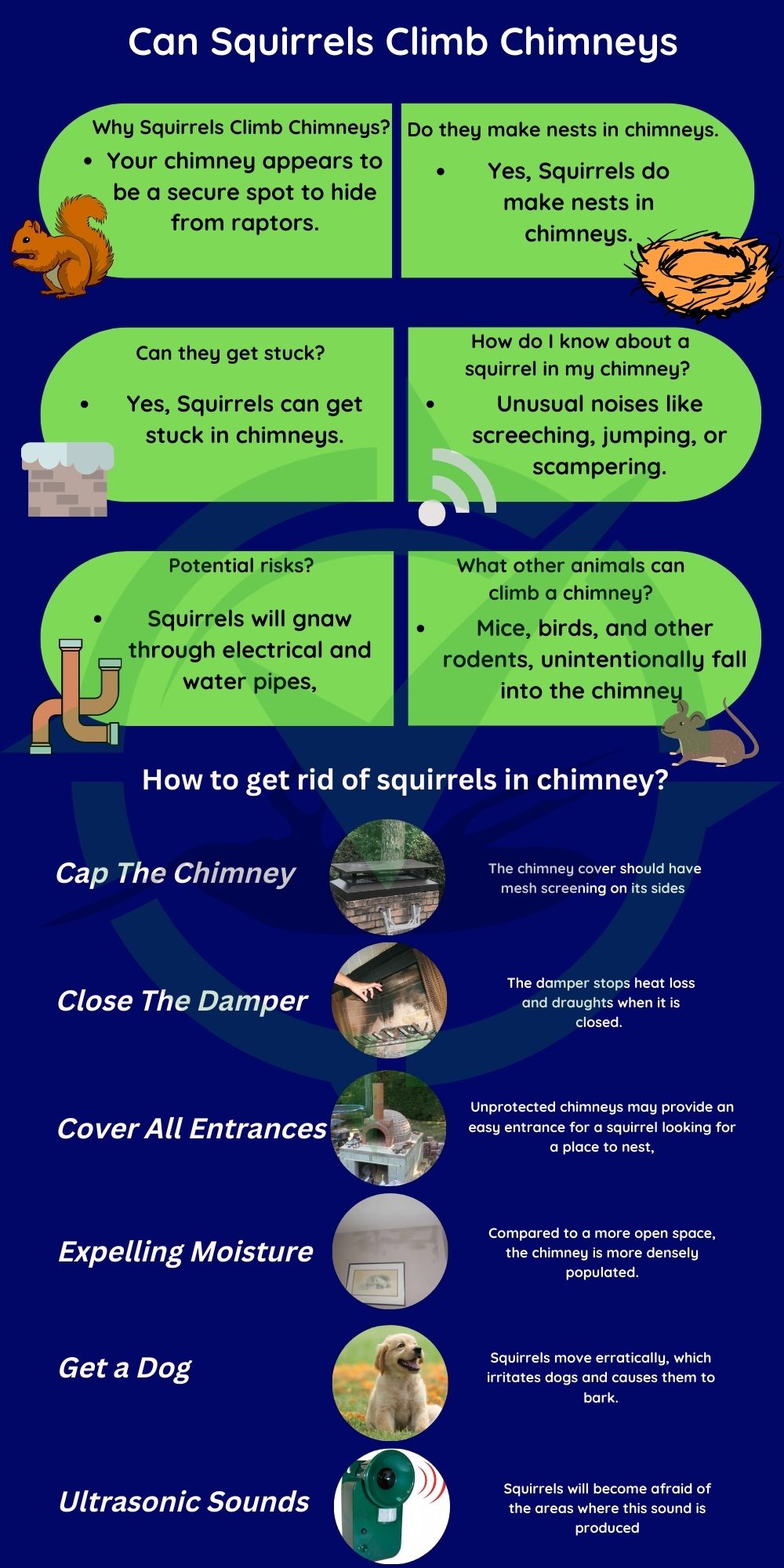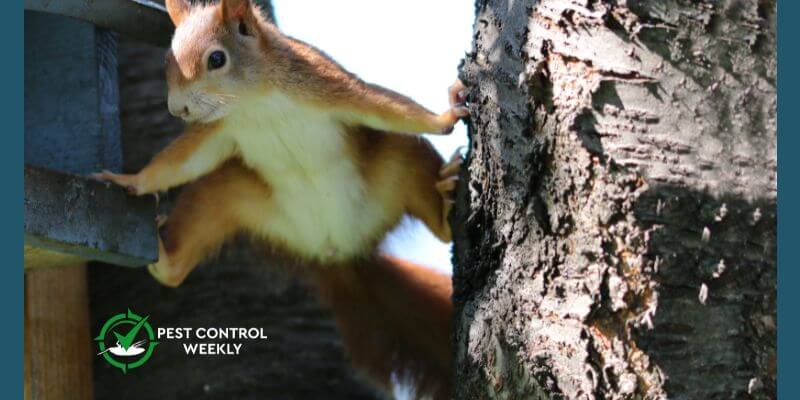Squirrels are agile climbers and a common pest that can enter or climb a property in several ways and usually live in the attic. Sometimes I notice squirrels in the chimneys so the question is can squirrels climb chimneys?
Yes, squirrels can climb chimneys. Squirrels can fall into vents from trees or other high places and get caught there. Other causes for squirrels to raise ducts include avoiding predators or seeking a safe place to make a nest.
This article covers all the information you require regarding squirrels in your chimney and solutions to the problem, so keep reading the article.

Why Squirrels Climb Chimneys?
Squirrels will climb up a chimney and make their home in the area above a fireplace. You might probably encounter squirrels in your chimney for many reasons.
They may even hide from neighborhood predators like dogs, cats, or other animals, and your chimney is the first structure they perceive.
Another possibility is that the squirrel was driven from its natural habitat by more giant squirrels or other creatures. Your chimney appears to be a secure spot to hide from raptors.
Squirrels are more likely to participate in this behavior in the winter, but they can enter open chimneys at any time of the year.
Additionally, sure chimneys are particularly vulnerable to these animals because of how easily squirrels may pass through brick-lined flues. However, once squirrels enter your chimney, they frequently stumble and find it difficult to climb out again.
Do Squirrels Make Nests In Chimneys?
Yes, Squirrels do make nests in chimneys. Raccoons, chimney swifts, squirrels, and bats are the most frequent creatures to make their home in chimneys resemble hollowed-out trees quite a bit.
They would be able to get there and travel in and out without any issues because they are also excellent climbers.
When choosing a nesting location, a female squirrel will climb around trees, buildings, and any other dry, safe-looking location.
The ideal solution is an open chimney without a chimney cap. After picking your chimney, the squirrel descends the flue and builds a nest at the bottom.
The squirrels’ nests are built in a highly compact manner, making them exceedingly challenging to dismantle. Even very large ones could fill a significant portion of the chimney and take hours to remove.
Can Squirrels Get Stuck In Chimneys?
Yes, Squirrels can get stuck in chimneys. Squirrels are just one of the many animals that can fall into your chimney if it isn’t adequately protected with a cap.
Squirrels can usually climb out of vents made of cementitious material, rocks, or cinderblock because there are corners and crevices to hold onto.
They will become stuck in the case of slick metal tubes. They can sometimes be seen clinging to the walls of houses, chimneys, downspouts, fences, and other structures.
Although they appear to be stuck, they simply do not know what their next step should be. They will learn how to maneuver themselves over time by observing each other or their mother.
Squirrels can sometimes get into your attic and then inside your walls. Most of the time, they are intelligent and physically capable of climbing back up, but not always.
Can Squirrels Get Out Of The Chimney Itself?
As long as the chimney is composed of mortar, stone, or brick because there are nooks and crevices to grab onto, squirrels can climb out themselves. They will become trapped if the metal tubes are slippery.
While squirrels find it easy to enter the chimney, getting out is not so simple. They often become trapped in the chimney, and without food or water, they perish.
They attract birds, rats, and other pests with their droppings and the foul smell of a decaying carcass. Before you realize it, your chimney flue is stopped.
Setting a squirrel chimney trap at the top of the flue, which captures the rodent as it emerges, is the best way to get a squirrel out of your chimney.
If there are any young inside the nest, they can then be taken safely using a long chimney snare pole, ideally by a wildlife expert.
How Do We Know If Squirrels Are Getting On Chimneys?
Unusual noises like screeching, jumping, or scampering are likely to be heard. Additionally, as squirrels are known to chew through a variety of objects, you’ll frequently hear gnawing noises.
There’s a significant probability that the squirrel is stuck in your chimney and unable to escape if you continuously hear scratching noises.
Although they can occasionally be confused for those of other animals, squirrel droppings can frequently be found when you investigate your fireplace. Anytime you discover droppings, you should contact a professional to help you identify the animal and arrange for its humane removal.
Another clear sign that a squirrel has taken up residence in your attic is holed on or near your chimney. However, squirrels in the chimney can cause a variety of issues, so it’s critical to understand when you may have a squirrel in your chimney.
What Are the Potential Risks of Having Squirrels In Your Chimney?
Squirrels need to gnaw to prevent their incisor teeth from becoming too long because they are constantly developing, and frequently the roof timbers in your basement are the ideal location for them to do so.
In contrast, squirrels will gnaw through electrical and water pipes, which can seriously harm your home and be expensive to fix.
Squirrels may seem like charming companions, but they can cause damage that might be quite expensive. They will look for food and water inside the chimney. They will scrabble and bite on anything they can find in a desperate attempt to escape the chimney.
The smell of squirrel poop and urine seeps into your surfaces, furniture, upholstery, and other areas of your dwelling. Additionally, there is a chance of getting sick from airborne infections that are present in the animal’s feces and urine. They can be spreading rabies, and other diseases like other rodents and pests do.
Which Other Animals Can Climb Chimneys Except for Squirrels?
Some pests, including mice, birds, and other rodents, unintentionally fall into the chimney while attempting to flee from predators. However, because the inside of the chimney is slippery, they frequently struggle to obtain enough grip to climb out again.
Pests that unintentionally become stuck make a lot of noise to let people know they’re there. Swifts, raccoons, and bats can occasionally be found in the chimney.
Swifts, little grey birds, can survive within your chimney because they fly up and down the flue in a vertical motion.
Chimneys are popular with raccoons because they mimic trees. Raccoon females give birth to young in the early spring and will contract the flues to do so in a secure environment.
Bats’ presence can be determined by listening to their quick, high-pitched chirps. Because chimneys are so close to the ground and are simple for bats to enter, they often fly into them.
[6] Ways To Stop Squirrels from Climbing Chimneys
Squirrels shouldn’t hang around in your chimney since it’s dangerous. It is strongly advised that you get professional assistance if you think your chimney may be home to squirrels or other pests.
Any squirrels in your chimney will be removed by Chimney Solutions. However, there are a few techniques you can try to stop a squirrel from climbing a chimney:
Cap The Chimney
The chimney cover should have mesh screening on its sides to prevent birds, raccoons, squirrels, and other animals from entering your chimney. Although chimney caps come in several forms and styles, even the most straightforward ones will offer the security you need.
These covers prevent squirrels from climbing chimneys and building nests in your chimney. The mesh makes sure the chimney operates properly.
Try using a mesh that is thicker so that raccoon or squirrel claws and teeth will not be able to tear it. These animals can be tenacious when hunting for a secure location to build their nests.
Close The Damper
Just above the firebox, there is a metal door called a damper in the chimney. Smoke and gas from a lighted fire flow up the chimney flue when the damper is open. The damper stops heat loss and draughts when it is closed. Stop changing the airflow, a lever or chain is used.
A chimney may resemble a hollow tree to a little mouse, making it a perfect location to create a nest. In the absence of a damper, rodents will enter homes through chimneys. When the fireplace is not in use, keep the damper closed.
Cover All entrances Near Your House
Unprotected chimneys may provide an easy entrance for a squirrel looking for a place to nest, but this is by no means the only way they can enter your house.
Squirrels can potentially enter your home through broken windows and doors, cracks in the foundation, gaps in the roof or along the roofline, and other difficult-to-see openings; therefore, these issues should be patched up or fixed before the rodents have a chance to do so.
Additionally, it could be a good idea to hire a pest exclusion specialist to perform a comprehensive check to find those particularly challenging entrance places.
Expelling Moisture
Compared to a more open space, like your attic, the chimney is more densely populated. This means that employing expulsion liquid or predator pee can aid in getting the squirrel to move on.
Raccoon eviction fluid, which is composed of the male raccoon’s urine and other bodily fluids, might scare a female squirrel away because she will believe that her family is in danger and that there is a male raccoon nearby.
When that happens, she will go on to locate a far safer location to keep her family secure.
Get A Dog
Dogs bark at squirrels because they become easily frustrated when they encounter an unknown animal. Squirrels move erratically, which irritates dogs and causes them to bark.
Most dogs enjoy chasing squirrels. Place them on squirrel patrol and allow them to scare the squirrels away.
To be sure, this isn’t the most ideal or practical solution. If you have a dog that naturally barks at squirrels, let them bark away; it will keep the squirrels away. If you see squirrels attempting to climb chimneys, you can also play recordings of a dog barking.
Ultrasonic Sounds
Ultrasonic pest deterrents have grown in popularity because they emit sounds that humans cannot hear but are extremely painful to squirrels.
Squirrels will become afraid of the areas where this sound is produced because it causes them a lot of discomforts, so they can be quite useful to use whenever squirrels try to climb chimneys.
Squirrels usually get around by learning where the sound devices are. At the same time, gardeners have praised these solutions. They do have limitations. You should change the positioning now and then, just like with other methods, to keep them alert.
Conclusion
It is well knowledge that squirrels may enter a variety of areas, including walls, chimneys, and crawl spaces. Squirrels can frequently be discovered in attics and occasionally fall into chimneys if they manage to enter your home.
Squirrels may accidentally enter your chimney from time to time and depart on their own, or they may grow content in your chimney and decide to stay there forever.
Squirrels can be very challenging to catch. They have great climbing ability and are adept at avoiding larger animals. You can use the method discussed above if a squirrel is in your chimney.
References
Chow Pizza Ka Yee, Clayton Nicola S., Steele Michael A. Cognitive Performance of Wild Eastern Gray Squirrels (Sciurus carolinensis) in Rural and Urban, Native, and Non-native Environments, Frontiers in Ecology and Evolution, 2021
